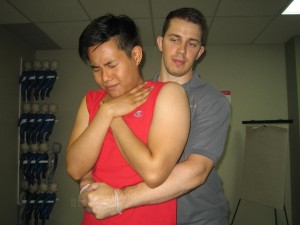Adults are more likely to choke on a piece of food, such as a large part of the meat, sausage or grape. Infants do not have well developed swallowing reflexes and may choke once small foods such as peanuts or hard candies are given. Children, especially toddlers, may choke on toys, coins and other indelible objects that they place in their mouths.
Coughing is usually the first symptom and is may be so severe that the person often can even not ask for help or speak. The person may also grasp both hands over or near the throat. Breathing or speaking can be difficult but may produce high pitched sounds or snoring sounds. The person may also turn blue, have a seizure or faint.
The material posted on this page on choking emergencies is for learning purposes only. To learn to recognize and manage breathing emergencies such as choking register for a CPR course with one of our Canadian providers.
First aid treatment for choking

Cough
A strong cough often expels the object from the airway. If the person is still able to cough (best if the cough is strong), let him do so continually until the obstructing object is expelled. If the person is not able to cough, the Heimlich maneuver should be performed.
Heimlich Maneuver
If the person is conscious, the rescuer approaches from behind, and then circles his hand around the person’s abdomen. The rescuer should form a fist, positioning the thumb pointing inward and placing it between the navel and the breastbone. The other hand should be firmly pressed over the fisted hand. The hands are then thrust upward and inward forcefully, 5 times in succession. After 5 thrusts the rescuer should position him or herself next the the victim and position the choking victim with his or her airway parallel to the floor. The rescuer should apply 5 consecutive back blows between the shoulder blades with an open palm. Less force is applied if the choking person is a child. Series of a thrust and back blows are continually repeated until the obstructing object is expelled. If the person loses consciousness, the thrusts should be stopped, 9-1-1 should be contacted and the rescuer should check the airway for any obstructions. To do this the rescuer should use a head-tilt- chin lift technique with a “hook and look” manoeuvre to position the tongue downwards for the rescuer to see the back of the throat. If the rescuer sees the obstruction he or she should try to remove it using a “sweep” with the index finger. Ventilations should follow which are then followed with chest compressions (30 times). Following the chest compressions the rescuer should check the throat. This cycle is repeated until the object is removed, the victim regains consciousness or help arrives.
To learn more about childcare rescue techniques register for a course by clicking here.
Reference:
WebMd. Choking Treatment. Retrieved on June 14, 2014 from http://www.webmd.com/first-aid/choking-treatment
